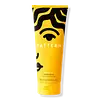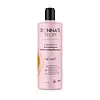What's inside
What's inside
 Key Ingredients
Key Ingredients

 Benefits
Benefits

 Concerns
Concerns

 Ingredients Side-by-side
Ingredients Side-by-side

Water
Skin ConditioningCetearyl Alcohol
EmollientBehentrimonium Methosulfate
Caprylic/Capric Triglyceride
MaskingButylene Glycol
HumectantBiotin
AntiseborrhoeicPanthenol
Skin ConditioningSimmondsia Chinensis Seed Oil
EmollientRicinus Communis Seed Oil
MaskingPersea Gratissima Oil
Skin ConditioningOlea Europaea Fruit Oil
MaskingMelaleuca Alternifolia Leaf Oil
AntioxidantMel
EmollientCocos Nucifera Oil
MaskingArgania Spinosa Kernel Oil
EmollientPrunus Amygdalus Dulcis Oil
Skin ConditioningButyrospermum Parkii Oil
EmollientHydrolyzed Vegetable Protein Pg-Propyl Silanetriol
Skin ConditioningAloe Barbadensis Leaf Extract
EmollientTocopherol
AntioxidantPolyquaternium-37
Propylene Glycol Dicaprylate/Dicaprate
EmollientEthylhexylglycerin
Skin ConditioningTrideceth-3
EmulsifyingTrideceth-15
EmulsifyingCetrimonium Chloride
AntimicrobialAmodimethicone
Parfum
MaskingPPG-1 Trideceth-6
Skin ConditioningGlycerin
HumectantAminomethyl Propanol
BufferingPhenoxyethanol
PreservativeCitric Acid
BufferingAlcohol
AntimicrobialAcetic Acid
BufferingPotassium Sorbate
PreservativeDisodium EDTA
Linalool
PerfumingAmyl Cinnamal
PerfumingButylphenyl Methylpropional
PerfumingBenzyl Benzoate
AntimicrobialHydroxycitronellal
PerfumingCitronellol
PerfumingCoumarin
PerfumingLimonene
PerfumingHexyl Cinnamal
PerfumingWater, Cetearyl Alcohol, Behentrimonium Methosulfate, Caprylic/Capric Triglyceride, Butylene Glycol, Biotin, Panthenol, Simmondsia Chinensis Seed Oil, Ricinus Communis Seed Oil, Persea Gratissima Oil, Olea Europaea Fruit Oil, Melaleuca Alternifolia Leaf Oil, Mel, Cocos Nucifera Oil, Argania Spinosa Kernel Oil, Prunus Amygdalus Dulcis Oil, Butyrospermum Parkii Oil, Hydrolyzed Vegetable Protein Pg-Propyl Silanetriol, Aloe Barbadensis Leaf Extract, Tocopherol, Polyquaternium-37, Propylene Glycol Dicaprylate/Dicaprate, Ethylhexylglycerin, Trideceth-3, Trideceth-15, Cetrimonium Chloride, Amodimethicone, Parfum, PPG-1 Trideceth-6, Glycerin, Aminomethyl Propanol, Phenoxyethanol, Citric Acid, Alcohol, Acetic Acid, Potassium Sorbate, Disodium EDTA, Linalool, Amyl Cinnamal, Butylphenyl Methylpropional, Benzyl Benzoate, Hydroxycitronellal, Citronellol, Coumarin, Limonene, Hexyl Cinnamal
Water
Skin ConditioningSodium Cocoyl Isethionate
CleansingCocamidopropyl Hydroxysultaine
CleansingSodium Methyl Cocoyl Taurate
CleansingGlycol Distearate
EmollientCetyl Alcohol
EmollientAcrylates Copolymer
Ipomoea Batatas Tuber Extract
AntioxidantCinnamomum Zeylanicum Bark Extract
AntimicrobialVanilla Planifolia Fruit Extract
Skin ConditioningAvena Sativa Kernel Extract
AbrasivePEG-40 Hydrogenated Castor Oil
EmulsifyingHelianthus Annuus Seed Oil
EmollientRosmarinus Officinalis Extract
AntimicrobialSilk Amino Acids
HumectantHydrolyzed Wheat Protein
Skin ConditioningAloe Barbadensis Leaf Extract
EmollientTocopheryl Acetate
AntioxidantButyrospermum Parkii Butter
Skin ConditioningCocos Nucifera Oil
MaskingMangifera Indica Seed Butter
Skin ConditioningPersea Gratissima Oil
Skin ConditioningHydrogenated Vegetable Oil
EmollientPropanediol
SolventStearamidopropyl Dimethylamine
EmulsifyingPanthenol
Skin ConditioningGuar Hydroxypropyltrimonium Chloride
Skin ConditioningTetrasodium EDTA
Sodium Benzoate
MaskingPotassium Sorbate
PreservativeEthylhexylglycerin
Skin ConditioningPhenoxyethanol
PreservativeCitric Acid
BufferingParfum
MaskingAroma
Water, Sodium Cocoyl Isethionate, Cocamidopropyl Hydroxysultaine, Sodium Methyl Cocoyl Taurate, Glycol Distearate, Cetyl Alcohol, Acrylates Copolymer, Ipomoea Batatas Tuber Extract, Cinnamomum Zeylanicum Bark Extract, Vanilla Planifolia Fruit Extract, Avena Sativa Kernel Extract, PEG-40 Hydrogenated Castor Oil, Helianthus Annuus Seed Oil, Rosmarinus Officinalis Extract, Silk Amino Acids, Hydrolyzed Wheat Protein, Aloe Barbadensis Leaf Extract, Tocopheryl Acetate, Butyrospermum Parkii Butter, Cocos Nucifera Oil, Mangifera Indica Seed Butter, Persea Gratissima Oil, Hydrogenated Vegetable Oil, Propanediol, Stearamidopropyl Dimethylamine, Panthenol, Guar Hydroxypropyltrimonium Chloride, Tetrasodium EDTA, Sodium Benzoate, Potassium Sorbate, Ethylhexylglycerin, Phenoxyethanol, Citric Acid, Parfum, Aroma
Ingredients Explained
These ingredients are found in both products.
Ingredients higher up in an ingredient list are typically present in a larger amount.
Aloe Barbadensis Leaf Extract is an extract of the leaves of the aloe, Aloe barbadensis, Liliaceae.
Aloe is one of the most well-known natural soothing ingredients, and for good reason. It’s full of water and has a cooling, calming effect on the skin, especially when it’s sunburned, itchy, or irritated. Aloe also helps your skin stay hydrated and smooth by mimicking what healthy skin naturally produces. On top of that, it contains vitamins and nutrients that support skin recovery.
It doesn’t protect you from the sun, but it can help your skin bounce back after too much time in it.
Let’s get into the details:
Aloe contains antioxidant Vitamins A, C, and E, which help fight off free radicals (unstable molecules from things like pollution that can damage your skin).
It’s also rich in polysaccharides, which are natural sugars that help hydrate the skin by acting like the skin’s own moisturizing agents. These, along with other sugars like monosaccharides, help form a protective barrier that locks in moisture.
Aloe works as both a humectant and an emollient. That means it draws water into the skin (humectant) and helps trap it there (emollient), making it an effective natural moisturizer.
You’ll also find a mix of other skin-supporting ingredients in aloe, including folic acid, choline, calcium, amino acids, fatty acids, and even Vitamin B12.
Out of the 420+ species of aloe, Aloe barbadensis is the most widely used in skincare products thanks to its gentle yet effective properties.
There are over 420 species of aloe but Aloe Barbadensis is the most commonly used for topical products.
Learn more about Aloe Barbadensis Leaf ExtractCitric Acid is an alpha hydroxy acid (AHA) naturally found in citrus fruits like oranges, lemons, and limes.
Like other AHAs, citric acid can exfoliate skin by breaking down the bonds that hold dead skin cells together. This helps reveal smoother and brighter skin underneath.
However, this exfoliating effect only happens at high concentrations (20%) which can be hard to find in cosmetic products.
Due to this, citric acid is usually included in small amounts as a pH adjuster. This helps keep products slightly more acidic and compatible with skin's natural pH.
In skincare formulas, citric acid can:
While it can provide some skin benefits, research shows lactic acid and glycolic acid are generally more effective and less irritating exfoliants.
Most citric acid used in skincare today is made by fermenting sugars (usually from molasses). This synthetic version is identical to the natural citrus form but easier to stabilize and use in formulations.
Read more about some other popular AHA's here:
Learn more about Citric AcidCocos Nucifera Oil is obtained from the kernels of the coconut fruit. In other words, this is coconut oil.
Coconut Oil is rich in fatty acids with lauric acid making up the majority of these. It also contains linoleic acid. Due to this high fatty acid content, coconut oil helps trap moisture and soften skin.
Despite being antibacterial, coconut oil may not be great for acne-prone skin. It is comedogenic and may clog pores. This ingredient may not be safe for malassezia or fungal acne.
Note: Coconut Oil should not replace your sunscreen for UV protection. Studies show it only blocks about 20% of UV.
This oil is non-volatile and has a light scent.
The term 'fragrance' is not regulated in many countries. In many cases, it is up to the brand to define this term. For instance, many brands choose to label themselves as "fragrance-free" because they are not using synthetic fragrances. However, their products may still contain ingredients such as essential oils that are considered a fragrance.
Learn more about Cocos Nucifera OilEthylhexylglycerin (we can't pronounce this either) is commonly used as a preservative and skin softener. It is derived from glyceryl.
You might see Ethylhexylglycerin often paired with other preservatives such as phenoxyethanol. Ethylhexylglycerin has been found to increase the effectiveness of these other preservatives.
Panthenol is a common ingredient that helps hydrate and soothe the skin. It is found naturally in our skin and hair.
There are two forms of panthenol: D and L.
D-panthenol is also known as dexpanthenol. Most cosmetics use dexpanthenol or a mixture of D and L-panthenol.
Panthenol is famous due to its ability to go deeper into the skin's layers. Using this ingredient has numerous pros (and no cons):
Like hyaluronic acid, panthenol is a humectant. Humectants are able to bind and hold large amounts of water to keep skin hydrated.
This ingredient works well for wound healing. It works by increasing tissue in the wound and helps close open wounds.
Once oxidized, panthenol converts to pantothenic acid. Panthothenic acid is found in all living cells.
This ingredient is also referred to as pro-vitamin B5.
Learn more about PanthenolParfum is a catch-all term for an ingredient or more that is used to give a scent to products.
Also called "fragrance", this ingredient can be a blend of hundreds of chemicals or plant oils. This means every product with "fragrance" or "parfum" in the ingredients list is a different mixture.
For instance, Habanolide is a proprietary trade name for a specific aroma chemical. When used as a fragrance ingredient in cosmetics, most aroma chemicals fall under the broad labeling category of “FRAGRANCE” or “PARFUM” according to EU and US regulations.
The term 'parfum' or 'fragrance' is not regulated in many countries. In many cases, it is up to the brand to define this term.
For instance, many brands choose to label themselves as "fragrance-free" because they are not using synthetic fragrances. However, their products may still contain ingredients such as essential oils that are considered a fragrance by INCI standards.
One example is Calendula flower extract. Calendula is an essential oil that still imparts a scent or 'fragrance'.
Depending on the blend, the ingredients in the mixture can cause allergies and sensitivities on the skin. Some ingredients that are known EU allergens include linalool and citronellol.
Parfum can also be used to mask or cover an unpleasant scent.
The bottom line is: not all fragrances/parfum/ingredients are created equally. If you are worried about fragrances, we recommend taking a closer look at an ingredient. And of course, we always recommend speaking with a professional.
Learn more about ParfumPersea Gratissima Oil is also known as avocado oil.
Avocado Oil has antioxidant properties. It is mostly made up of the glycerides of fatty acids. About 67% of these fatty acids is made up of oleic acid. Palmitic acid and linoleic acid are also present.
These fatty acids help hydrate and soften the skin. It may increase collagen content in the skin. Collagen helps keep your skin plump and firm. This ingredient helps reduce inflammation and has not shown to clog pores.
This ingredient may not be fungal-acne safe due to its high fatty acid content.
Avocados also have B vitamins, vitamin K, vitamin C, vitamin E, and potassium.
Learn more about Persea Gratissima OilPhenoxyethanol is a preservative that has germicide, antimicrobial, and aromatic properties. Studies show that phenoxyethanol can prevent microbial growth. By itself, it has a scent that is similar to that of a rose.
It's often used in formulations along with Caprylyl Glycol to preserve the shelf life of products.
Potassium Sorbate is a preservative used to prevent yeast and mold in products. It is commonly found in both cosmetic and food products.
This ingredient comes from potassium salt derived from sorbic acid. Sorbic acid is a natural antibiotic and effective against fungus.
Both potassium sorbate and sorbic acid can be found in baked goods, cheeses, dried meats, dried fruit, ice cream, pickles, wine, yogurt, and more.
You'll often find this ingredient used with other preservatives.
Learn more about Potassium SorbateWater. It's the most common cosmetic ingredient of all. You'll usually see it at the top of ingredient lists, meaning that it makes up the largest part of the product.
So why is it so popular? Water most often acts as a solvent - this means that it helps dissolve other ingredients into the formulation.
You'll also recognize water as that liquid we all need to stay alive. If you see this, drink a glass of water. Stay hydrated!
Learn more about Water